Instructions for Side by Side Printing
- Print the notecards
- Fold each page in half along the solid vertical line
- Cut out the notecards by cutting along each horizontal dotted line
- Optional: Glue, tape or staple the ends of each notecard together
AP Biology Chapter 26
front 1 The legless condition that is observed in several groups of extant
reptiles is the result of | back 1 C |
front 2 The scientific discipline concerned with naming organisms is
called | back 2 A |
front 3 ) The various taxonomic levels (viz, genera, classes, etc.) of the
hierarchical classification | back 3 C |
front 4 Which of these illustrates the correct representation of the binomial
scientific name for the | back 4 E |
front 5 A phylogenetic tree that is ʺrootedʺ is one | back 5 B |
front 6 The correct sequence, from the most to the least comprehensive, of
the taxonomic levels | back 6 B |
front 7 The common housefly belongs to all of the following taxa. Assuming
you had access to | back 7 C |
front 8 If organisms A, B, and C belong to the same class but to different
orders and if organisms | back 8 E |
front 9 Darwin analogized the effects of evolution as the above-ground
portion of a | back 9 B |
front 10 Dozens of potato varieties exist, differing from each other in
potato-tuber size, skin color, | back 10 E |
front 11 The term ʺhomoplasyʺ is most applicable to which of these
features? | back 11 A |
front 12 If, someday, an archaean cell is discovered whose SSU-rRNA sequence
is more similar to | back 12 B |
front 13 ) The best classification system is that which most closely | back 13 C |
front 14 Which of the following pairs are the best examples of homologous
structures? | back 14 A |
front 15 ) Some molecular data place the giant panda in the bear family
(Ursidae) but place the lesser | back 15 D |
front 16 In angiosperm plants, flower morphology can be very intricate. If a
tree, such as a New | back 16 D |
front 17 The importance of computers and of computer software to modern
cladistics is most closely | back 17 E |
front 18 ) Which mutation should least require realignment of homologous
regions of a gene that is | back 18 B |
front 19 The common ancestors of birds and mammals were very early (stem)
reptiles, which almost | back 19 C |
front 20 Generally, within a lineage, the largest number of shared derived
characters should be | back 20 D |
front 21 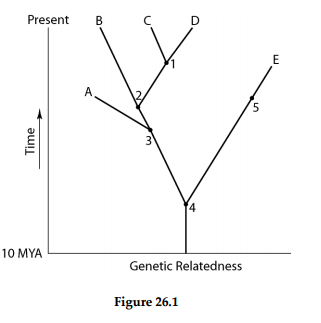 A common ancestor for both species C and E could be at position
number | back 21 D |
front 22  The two extant species that are most closely related to each other
are | back 22 C |
front 23  ) Which species are extinct? | back 23 A |
front 24  Which extinct species should be the best candidate to serve as the
outgroup for the clade | back 24 A |
front 25 If this evolutionary tree is an accurate depiction of relatedness,
then which of the following | back 25 E |
front 26 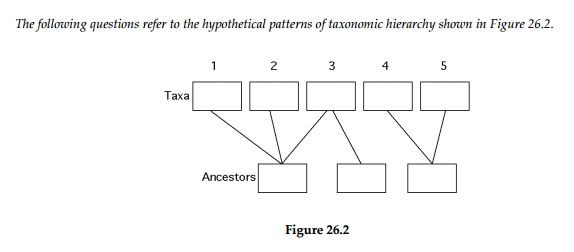 Which of the following numbers represents a polyphyletic
taxon? | back 26 B |
front 27  ) If this figure is an accurate depiction of relatedness, then which
taxon is unacceptable, | back 27 C |
front 28 ) Which of the following is not true of all horizontally oriented
phylogenetic trees, where | back 28 A |
front 29 Ultimately, which of these serves as the basis for both the principle
of maximum parsimony | back 29 C |
front 30 ) Shared derived characters are most likely to be found in taxa that
are | back 30 C |
front 31 A taxon, all of whose members have the same common ancestor,
is | back 31 C |
front 32 The term that is most appropriately associated with clade is | back 32 C |
front 33 If birds are excluded from the class Reptilia, the term that
consequently describes the class | back 33 A |
front 34 If the eukaryotic condition arose, independently, several different
times during | back 34 B |
front 35 When using a cladistic approach to systematics, which of the
following is considered most | back 35 C |
front 36 The four-chambered hearts of birds and the four-chambered hearts of
mammals evolved | back 36 D |
front 37 Phylogenetic hypotheses (such as those represented by phylogenetic
trees) are strongest | back 37 C |
front 38 Cladograms (a type of phylogenetic tree) constructed from evidence
from molecular | back 38 E |
front 39 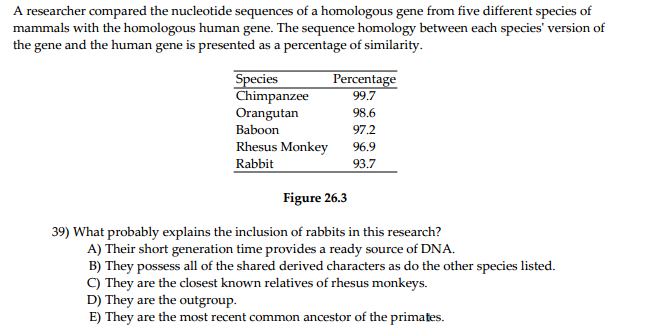 | back 39 D |
front 40 Based on the tabular data, and assuming that time advances
vertically, which cladogram (a | back 40 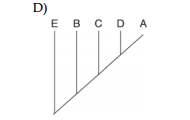 |
front 41 Regarding these sequence homology data, the principle of maximum
parsimony would be | back 41 D |
front 42 Which process hinders clarification of the deepest branchings in a
phylogenetic tree that | back 42 D |
front 43 What kind of evidence has recently made it necessary to assign the
prokaryotes to either of | back 43 A |
front 44 What important criterion was used in the late 1960s to distinguish
between the three | back 44 C |
front 45 Which is an obsolete kingdom that includes prokaryotic
organisms? | back 45 E |
front 46 Members of which kingdom have cell walls and are all
heterotrophic? | back 46 B |
front 47 ) Which kingdom has been replaced with two domains? | back 47 E |
front 48 Which eukaryotic kingdom is polyphyletic and therefore not
acceptable, based on | back 48 D |
front 49 Which eukaryotic kingdom includes members that are the result of
endosymbioses that | back 49 A |
front 50 The human nuclear genome includes hundreds of genes that are
orthologs of bacterial | back 50 B |
front 51 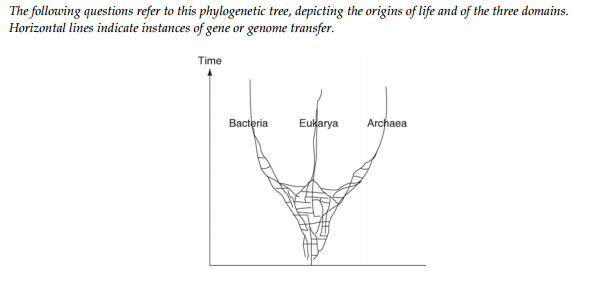 ) If the early history of life on Earth is accurately depicted by
this phylogenetic tree, then | back 51 D |
front 52  Which process is observed in prokaryotes and is responsible for the
vertical components of | back 52 D |
front 53  Which of these processes can be included among those responsible for
the horizontal | back 53 A |
front 54  Which portion of this tree may ultimately be better depicted as a
ʺringʺ? | back 54 D |
front 55  A large proportion of archaeans are ʺextremophiles,ʺ so called
because they inhabit extreme | back 55 B |
front 56 In Figure 26.4 from your textbook, which similarly inclusive taxon
descended from the | back 56 B |
front 57 Three living species X, Y, and Z share a common ancestor T, as do
extinct species U and V. | back 57 D |
front 58 In a comparison of birds with mammals, having four appendages
is | back 58 A |
front 59 If you were using cladistics to build a phylogenetic tree of cats,
which of the following | back 59 C |
front 60 The relative lengths of the amphibian and mouse branches in the
phylogeny in Figure 26.12 | back 60 D |
front 61  | back 61 D |
front 62 To apply parsimony to constructing a phylogenetic tree, | back 62 D |